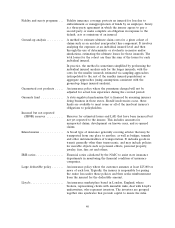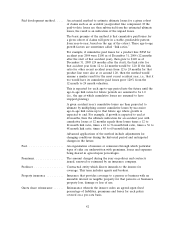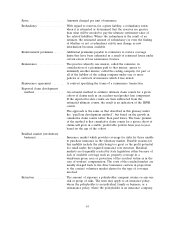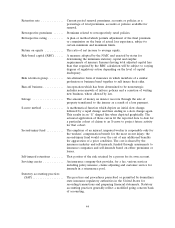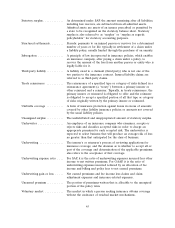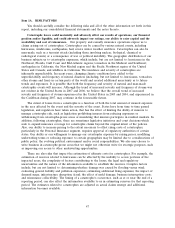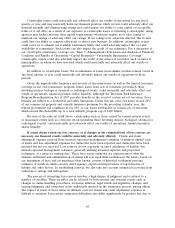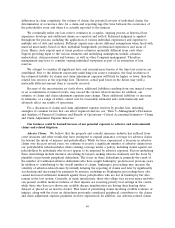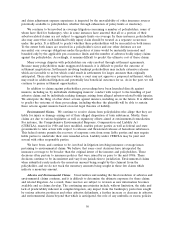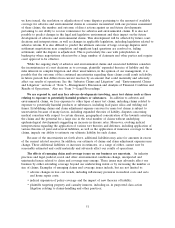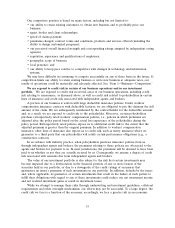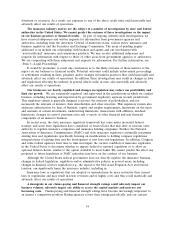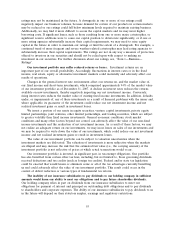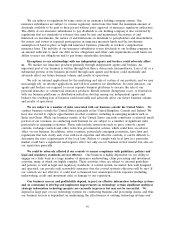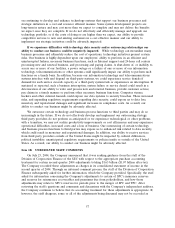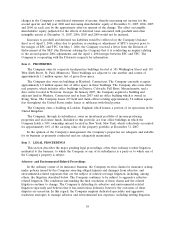Travelers 2007 Annual Report Download - page 60
Download and view the complete annual report
Please find page 60 of the 2007 Travelers annual report below. You can navigate through the pages in the report by either clicking on the pages listed below, or by using the keyword search tool below to find specific information within the annual report.Catastrophe losses could materially and adversely affect our results of operations for any fiscal
quarter or year and may materially harm our financial position, which in turn could adversely affect our
financial strength and claims-paying ratings and could impair our ability to raise capital on acceptable
terms or at all. Also, as a result of our exposure to catastrophe losses or following a catastrophe, rating
agencies may further increase their capital requirements, which may require us to raise capital to
maintain our ratings or adversely affect our ratings. If our ratings were adversely affected, this in turn,
could hurt our ability to compete effectively or attract new business. In addition, catastrophic events
could cause us to exhaust our available reinsurance limits and could adversely impact the cost and
availability of reinsurance. Such events can also impact the credit of our reinsurers. For a discussion of
our catastrophe reinsurance coverage, see ‘‘Item 7—Management’s Discussion and Analysis of Financial
Condition and Results of Operations—Capital Resources—Catastrophe Reinsurance Coverage.’’
Catastrophic events could also adversely impact the credit of the issuers of securities, such as states or
municipalities, in whom we have invested, which could materially and adversely affect our results of
operations.
In addition to catastrophe losses, the accumulation of losses from smaller weather-related events in
any fiscal quarter or year could materially and adversely impact our results of operations in those
periods.
Given the unpredictable frequency and severity of terrorism losses, as well as the limited terrorism
coverage in our own reinsurance program, future losses from acts of terrorism, particularly those
involving nuclear, biological, chemical or radiological events, could materially and adversely affect our
results of operations, financial position and/or liquidity. Although the Terrorism Risk Insurance
Program Reauthorization Act of 2007 provides benefits in the event of certain acts of terrorism, those
benefits are subject to a deductible and other limitations. Under this law, once our losses exceed 20%
of our commercial property and casualty insurance premium for the preceding calendar year, the
federal government will reimburse us for 85% of our losses attributable to certain acts of terrorism
which exceed this deductible up to a total industry program cap of $100 billion.
Because of the risks set forth above, catastrophes such as those caused by various natural events,
or man-made events such as a terrorist attack (including those involving nuclear, biological, chemical or
radiological events), could materially and adversely affect our results of operations, financial position
and/or liquidity.
If actual claims exceed our loss reserves, or if changes in the estimated level of loss reserves are
necessary, our financial results could be materially and adversely affected. Claims and claim
adjustment expense reserves (loss reserves) represent management’s estimate of ultimate unpaid costs
of losses and loss adjustment expenses for claims that have been reported and claims that have been
incurred but not yet reported. Loss reserves do not represent an exact calculation of liability, but
instead represent management estimates, generally utilizing actuarial expertise and projection
techniques, at a given accounting date. These loss reserve estimates are expectations of what the
ultimate settlement and administration of claims will cost upon final resolution in the future, based on
our assessment of facts and circumstances then known, reviews of historical settlement patterns,
estimates of trends in claims severity and frequency, expected interpretations of legal theories of
liability and other factors. In establishing reserves, we also take into account estimated recoveries from
reinsurance, salvage and subrogation.
The process of estimating loss reserves involves a high degree of judgment and is subject to a
number of variables. These variables can be affected by both internal and external events, such as
changes in claims handling procedures, economic inflation, legal trends and legislative changes, and
varying judgments and viewpoints of the individuals involved in the estimation process, among others.
The impact of many of these items on ultimate costs for claims and claim adjustment expenses is
difficult to estimate. Loss reserve estimation difficulties also differ significantly by product line due to
48




